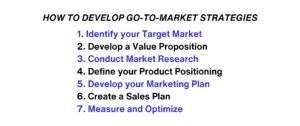Are you a product manager looking to take your go-to-market strategies to the next level? If so, you’ve come to the right place.
In today’s fast-paced business world, successful product launches rely on a well-executed go-to-market strategy. But with so many moving parts and channels to consider, it can be overwhelming to know where to start.
That’s why we’ve put together this blog to help you master go-to-market strategies and launch your product like a pro. What is a go-to-market strategy?
A go-to-market (GTM) strategy is a plan that helps businesses position a new product or service for launch, define their ideal customers, and coordinate messaging.
Designed to mitigate the risk of introducing a new product to market, a typical GTM strategy includes target market profiles, a marketing plan, and a concrete sales and distribution strategy.
We will cover everything you need to know to master go-to-market strategies, including:
- Understanding the basics of go-to-market strategy
- Identifying your target market and buyer personas
- Creating a unique value proposition
- Building a comprehensive marketing plan
- Optimizing your sales strategy
- Measuring and analyzing your results
One key aspect is developing a go-to-market (GTM) strategy. GTM strategies encompass all of the activities and tactics required to get your product in the hands of customers and achieve success in the market.
What are go-to-market strategies?
A go-to-market (GTM) strategy is a plan that helps businesses position a new product or service for launch, define their ideal customers, and coordinate messaging.
Designed to mitigate the risk of introducing a new product to market, a typical GTM strategy includes target market profiles, a marketing plan, and a concrete sales and distribution strategy.

1. Identify your Target Market
The first step to developing a successful go-to-market strategy is to identify your target market.
- Who are your customers?
- What are their pain points?
- What motivates them to buy?
The more you know about your target market, the better you’ll be able to tailor your product, messaging, and marketing efforts to their needs.
2. Develop a Value Proposition
Once you’ve identified your target market, the next step is to develop a value proposition. Your value proposition is a statement that clearly articulates the unique value your product brings to the market. It should be concise, specific, and communicate how your product solves your customers’ problems better than any alternative.
3. Conduct Market Research
Market research is the process of gathering and analyzing information about your target market, competition, and industry. It’s important to conduct market research to validate your assumptions about your target market, understand your competition, and identify opportunities and challenges in the market.
4. Define your Product Positioning
Product positioning refers to the way you position your product in the minds of your target customers. It’s how you differentiate your product from competitors and communicate its unique value. Your product positioning should align with your value proposition and address your customers’ needs and pain points.
5. Develop your Marketing Plan
Your marketing plan outlines the tactics and channels you’ll use to reach and engage your target market. It should include a mix of online and offline marketing activities, such as social media marketing, email marketing, content marketing, public relations, events, and advertising.
6. Create a Sales Plan
Your sales plan outlines the tactics and strategies you’ll use to sell your product to your target customers. It should include your sales process, pricing strategy, and distribution strategy. Your sales plan should be aligned with your marketing plan and support your overall go-to-market strategy.
7. Measure and Optimize
Finally, it’s essential to measure and optimize your go-to-market strategy. Set key performance indicators (KPIs) for each stage of the sales and marketing process, and use analytics tools to track your progress. Use this data to optimize your tactics and make informed decisions about future investments.
Elevate your product management skills to new heights with IIM-V’s Product Management certification! Our comprehensive course is designed to ignite your journey in product management with expertise and know-how.
Unleash your potential in this dynamic field by exploring our insightful blog page today. Don’t miss this opportunity to excel in product management!






